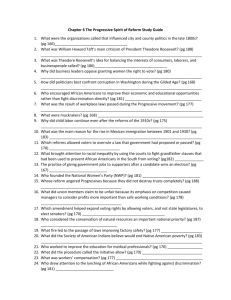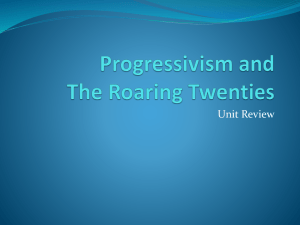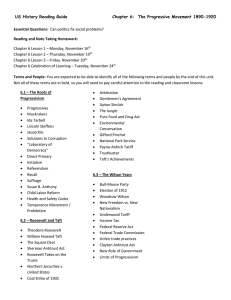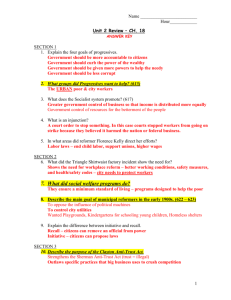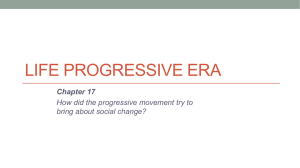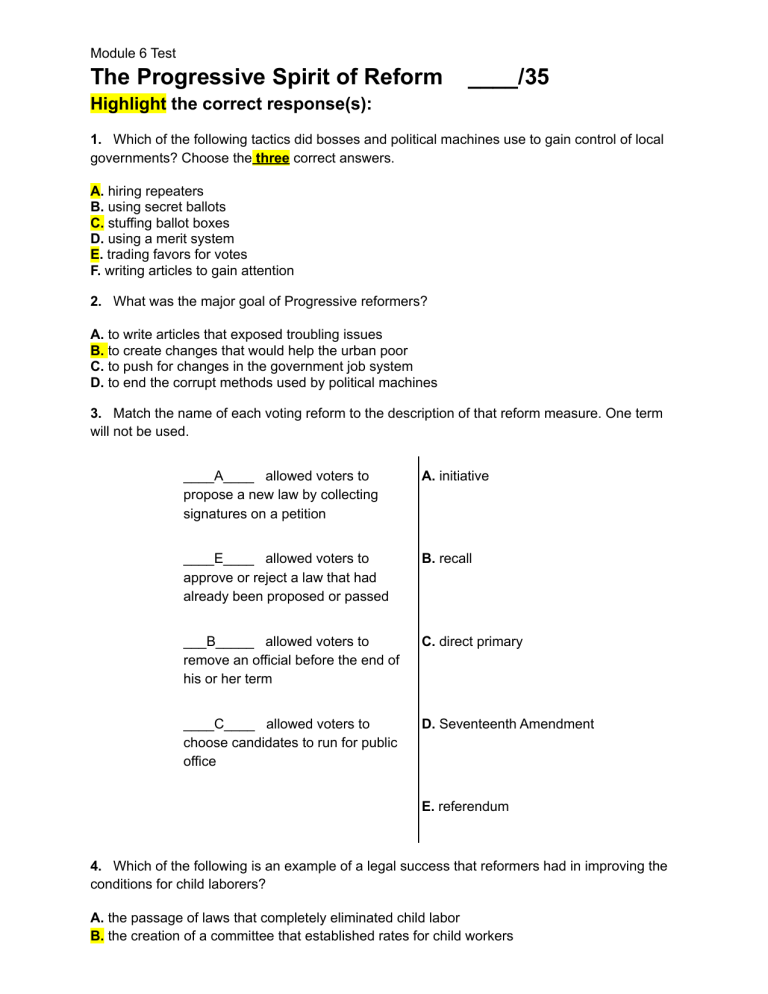
Module 6 Test The Progressive Spirit of Reform ____/35 Highlight the correct response(s): 1. Which of the following tactics did bosses and political machines use to gain control of local governments? Choose the three correct answers. A. hiring repeaters B. using secret ballots C. stuffing ballot boxes D. using a merit system E. trading favors for votes F. writing articles to gain attention 2. What was the major goal of Progressive reformers? A. to write articles that exposed troubling issues B. to create changes that would help the urban poor C. to push for changes in the government job system D. to end the corrupt methods used by political machines 3. Match the name of each voting reform to the description of that reform measure. One term will not be used. ____A____ allowed voters to propose a new law by collecting signatures on a petition A. initiative ____E____ allowed voters to approve or reject a law that had already been proposed or passed B. recall ___B_____ allowed voters to remove an official before the end of his or her term C. direct primary ____C____ allowed voters to choose candidates to run for public office D. Seventeenth Amendment E. referendum 4. Which of the following is an example of a legal success that reformers had in improving the conditions for child laborers? A. the passage of laws that completely eliminated child labor B. the creation of a committee that established rates for child workers C. the upholding of the federal child labor laws by the Supreme Court D. the passage of laws that punished parents for ignoring child labor laws 5. Which of the following are successes that labor unions and reformers had in improving working conditions? Choose the three correct answers. A. higher wages B. longer workweeks C. a twelve-hour workday D. laws ending child labor E. workers’ compensation laws F. laws restricting women’s working hours 6. Place an “X” in the table to show whether each characteristic describes the American Federation of Labor (AFL), the International Ladies’ Garment Workers’ Union (ILGWU), or the International Workers of the World (IWW). American Federation of Labor (AFL) International Ladies’ Garment Workers’ Union (ILGWU) believed in the system of socialism X organized the “Uprising of the 20,000” X included only skilled workers X led by Samuel Gompers X led by William “Big Bill” Haywood International Workers of the World (IWW) X 7. How did women’s involvement in the Progressive movement lead to constitutional change? A. Women reformers fought for the right to vote, which led to the passage of the Nineteenth Amendment. B. Many women took up the cause of temperance, which led to the passage of the Seventeenth Amendment. C. Women reformers campaigned for senators to be directly chosen, which led to the passage of the Sixteenth Amendment. D. Many women pushed for the government to impose direct income taxes, which led to the passage of the Eighteenth Amendment. 8. Match the name of each African American leader to the description of that person. ___B_____ believed that African Americans should not openly challenge segregation A. W. E. B. DuBois ____D____ wrote articles about the unequal education for African American children B. Booker T. Washington _____C___ formed the National Urban League to aid African Americans moving from the South C. Dr. George Edmund Haynes ___A_____ helped found the D. Ida B. Wells National Association for the Advancement of Colored People (NCAAP) 9. Which of the following correctly shows a limitation of Progressive reforms? A. The temperance movement largely failed to meet its goals. B. Women were not granted the right to vote in federal elections. C. African Americans were unsuccessful in using the courts to fight discrimination. D. New labor laws did not improve the living and working conditions of migrant workers. 10. Which of the following correctly shows how President Theodore Roosevelt supported Progressive reforms? A. He created a new, modern banking system. B. He convinced Congress to pass a meat inspection law. C. He viewed the protection of nature and its resources as unimportant. D. He started an agency to investigate and punish unfair trade practices. 11. How was the administration of William Howard Taft different from that of Theodore Roosevelt? A. Taft did not start any antitrust lawsuits. B. Taft was strongly opposed to socialism. C. Taft favored the regulation of big business. D. Taft moved cautiously with reform and regulation. 12. Place an “X” in the table to show whether each achievement is associated with President Theodore Roosevelt, President William Howard Taft, or President Woodrow Wilson. Theodore Roosevelt William Howard Taft backed the Underwood Tariff Act, which lowered tariffs was the first to use the Sherman Antitrust Act to break up a monopoly X X passed the Clayton Antitrust Act, which strengthened federal laws against monopolies X signed the Payne-Aldrich Tariff, which reduced some rates on imports but raised others X created the Federal Trade Commission to investigate and punish unfair trade practices convinced Congress to pass the Pure Food and Drug Act to stop the sale and transport of mislabeled food and drugs Woodrow Wilson X X
